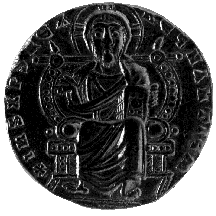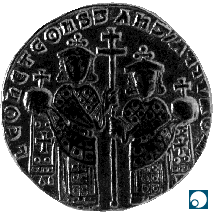



(144) Leo VI and Constantine VII - AV solidus, A.D. 908-912, 4.37
g. (inv. 91.287).
Obverse: Christ with cross-nimbus behind head, seated on
lyre-backed throne, r. raised in blessing, l. holding book; IhS(VS) XP(ISTO)S
REX REGNANTIVM: Jesus Christ, King of those who rule.
Reverse: Standing facing figures of Leo VI l. and Constantine
VII r., each wearing loros and crown with cross and holding globus
cruciger in outer hand and patriarchal cross between them; LEON ET CONSTANT(INVS)
AVGG (AVGVSTI abbreviated) ROM(AION): Leo and Constantine, Augusti of the
Romans.
Provenance: Edward Gans, 1959.
Bibliography: P. Grierson, Byzantine Coins (London
1982).
Leo VI (the Wise) came to the throne in A.D. 886, after his father, Basil
I, died in a hunting accident (see no. 143). Leo
was called "the Wise" not because he was a particularly sage ruler
but because he was a noted scholar who finished the revision of the legal
text, the Codex Justinianus, that Basil had begun, renaming it the
Basilica for his father.
For reasons not yet clearly understood, Leo VI apparently did not mint solidi
for the first twenty years of his reign. The solidi from his last years
continue with an improved version of the Christ enthroned introduced by
his father (see no. 143) on the obverse and with
standing portraits of Leo and his son Constantine VII, co-emperor after
A.D. 908, on the reverse. The portraits are interesting for their depiction
of the complex wrapping of the loros. The figures continue the convention
of showing the senior emperor in larger scale on the left, but Constantine
is depicted as nearly grown, while he was in fact a small child.
E.N.J.



All contents copyright (c) 1996.
Lawrence University
All rights reserved.